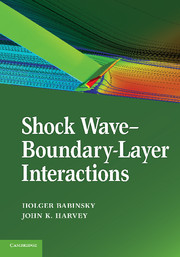Book contents
- Frontmatter
- Brief Contents
- Contents
- Contributors
- 1 Introduction
- 2 Physical Introduction
- 3 Transonic Shock Wave???Boundary-Layer Interactions
- 4 Ideal-Gas Shock Wave???Turbulent Boundary-Layer Interactions (STBLIs) in Supersonic Flows and Their Modeling: Two-Dimensional Interactions
- 5 Ideal-Gas Shock Wave???Turbulent Boundary-Layer Interactions in Supersonic Flows and Their Modeling: Three-Dimensional Interactions
- 6 Experimental Studies of Shock Wave???Boundary-Layer Interactions in Hypersonic Flows
- 7 Numerical Simulation of Hypersonic Shock Wave???Boundary-Layer Interactions
- 8 Shock Wave???Boundary-Layer Interactions Occurring in Hypersonic Flows in the Upper Atmosphere
- 9 Shock-Wave Unsteadiness in Turbulent Shock Boundary-Layer Interactions
- 10 Analytical Treatment of Shock Wave???Boundary-Layer Interactions
- Index
- References
3 - Transonic Shock Wave???Boundary-Layer Interactions
Published online by Cambridge University Press: 05 June 2012
- Frontmatter
- Brief Contents
- Contents
- Contributors
- 1 Introduction
- 2 Physical Introduction
- 3 Transonic Shock Wave???Boundary-Layer Interactions
- 4 Ideal-Gas Shock Wave???Turbulent Boundary-Layer Interactions (STBLIs) in Supersonic Flows and Their Modeling: Two-Dimensional Interactions
- 5 Ideal-Gas Shock Wave???Turbulent Boundary-Layer Interactions in Supersonic Flows and Their Modeling: Three-Dimensional Interactions
- 6 Experimental Studies of Shock Wave???Boundary-Layer Interactions in Hypersonic Flows
- 7 Numerical Simulation of Hypersonic Shock Wave???Boundary-Layer Interactions
- 8 Shock Wave???Boundary-Layer Interactions Occurring in Hypersonic Flows in the Upper Atmosphere
- 9 Shock-Wave Unsteadiness in Turbulent Shock Boundary-Layer Interactions
- 10 Analytical Treatment of Shock Wave???Boundary-Layer Interactions
- Index
- References
Summary
Introduction to Transonic Interactions
By definition, transonic shock wave–boundary layer interactions (SBLIs) feature extensive regions of supersonic and subsonic flows. Typically, such interactions are characterized by supersonic flow ahead of the shock wave and subsonic flow downstream of it. This mixed nature of the flow has important consequences that make transonic interactions somewhat different from supersonic or hypersonic interactions.
The key difference between transonic interactions and other SBLIs is the presence of subsonic flow behind the shock wave. Steady subsonic flow does not support waves (e.g., shock waves or expansion fans), and any changes of flow conditions are gradual in comparison to supersonic flow. This imposes constraints on the shock structure in the interaction region because the downstream flow conditions can feed forward and affect the strength, shape, and location of the shock wave causing the interaction. The flow surrounding a transonic SBLI must satisfy the supersonic as well as subsonic constraints imposed by the governing equations. The interaction also is sensitive to downstream disturbances propagating upstream in the subsonic regions. In contrast, supersonic interactions are “shielded” from such events by the supersonic outer flow.
Information
- Type
- Chapter
- Information
- Shock Wave-Boundary-Layer Interactions , pp. 87 - 136Publisher: Cambridge University PressPrint publication year: 2011
References
Accessibility standard: Unknown
Why this information is here
This section outlines the accessibility features of this content - including support for screen readers, full keyboard navigation and high-contrast display options. This may not be relevant for you.Accessibility Information
- 13
- Cited by
